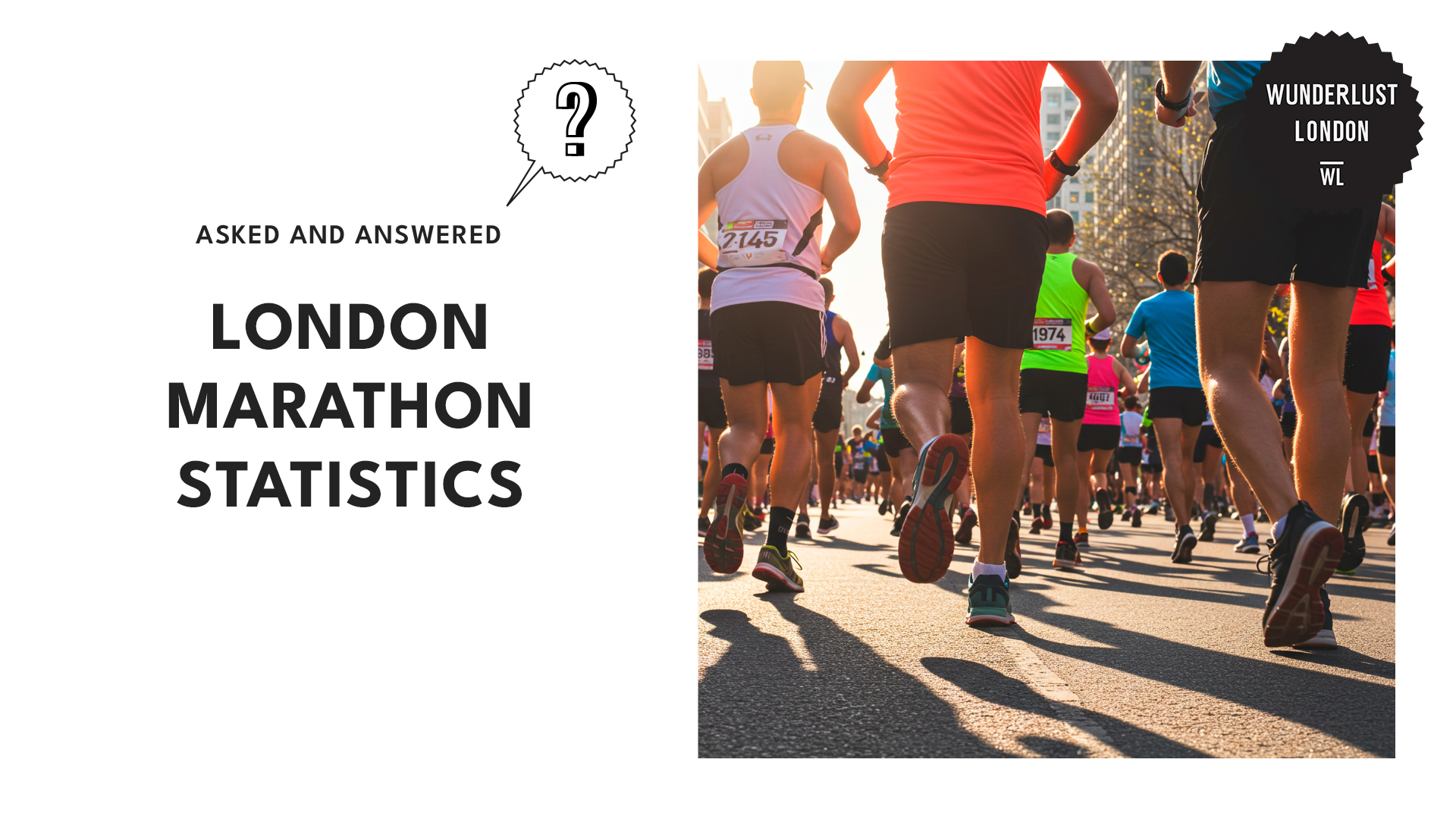Key insights
- According to the Institute of Chartered Accountants in England and Wales (ICAEW), the London Marathon has grown from 6,255 finishers in 1981 to over 53,000 in 2024.
- Race Insight data revealed a growing trend in marathon participation in London over the years, except in 2020, when the COVID-19 pandemic led to event restrictions.
- Kenyan runners dominate the fastest men’s marathon finishes, with only one Ethiopian winner, based on the data from the Olympics.
- According to the Race Insights data, male participants consistently exceeded female participants each year from 2014 to 2024.
- Race of Insight data also showed that 49.71% of participants are aged 18 to 39, making up nearly half of all entrants.
- Geeks on Feet reported that in the 2023 London Marathon, the USA led all non-UK countries with 3,214 finishers.
- In 2024, Reuters reported that the London Marathon raised a record £73.5 million for charity, bringing its total fundraising to over £1.3 billion since 1981.
- London Marathon Events confirmed a record-breaking 45 Guinness World Records set in the 2023 race, which is the highest in the event’s history.
- According to the London Daily, the 2025 London Marathon has set a new record with over 848,000 applications.
According to the Institute of Chartered Accountants in England and Wales (ICAEW), the London Marathon has grown significantly since its start in 1981, when just 6,255 people finished the race.
Over the years, its popularity has surged, with the event now attracting over 53,000 finishers in 2024.
Beyond the race itself, it has generated millions for charity and drawn runners worldwide.
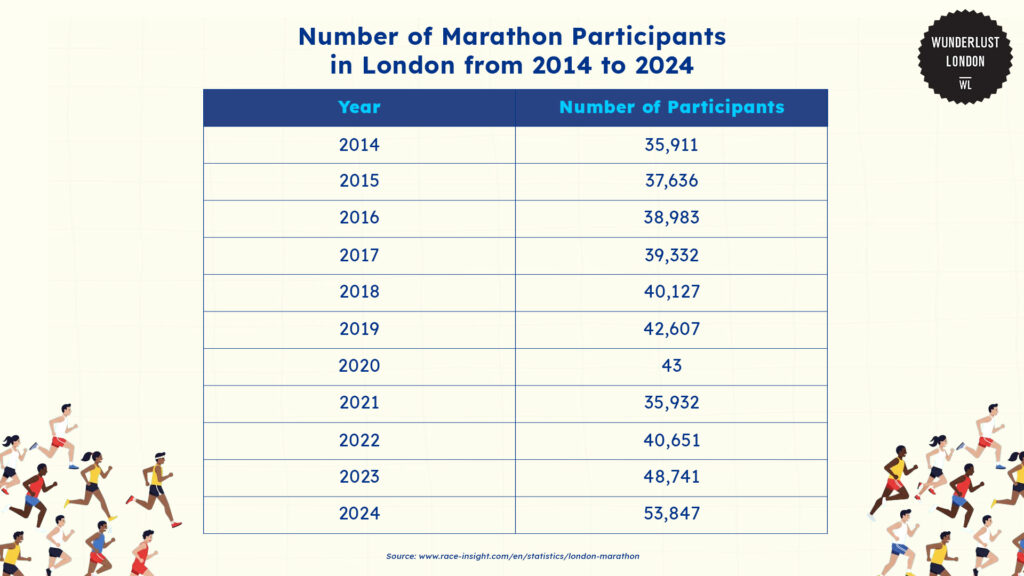
Race Insight data showed that there was an upward trend in marathon participation in London over the years, with a few notable disruptions. From 2014 to 2019, the number of participants steadily increased.
However, 2020 saw an extreme drop to just 43 participants due to the COVID-19 pandemic. Many public events were forced to be cancelled and lockdowns were implemented during the same time.
Participation started to recover in 2021, though it remained below pre-pandemic levels.
By 2022, numbers had nearly returned to normal, and the following years saw a significant increase in marathon participation. A sharp rise in 2023 and 2024 suggests a renewed enthusiasm for marathons, with participation exceeding pre-pandemic levels.
Record-breaking achievements in the London Marathon
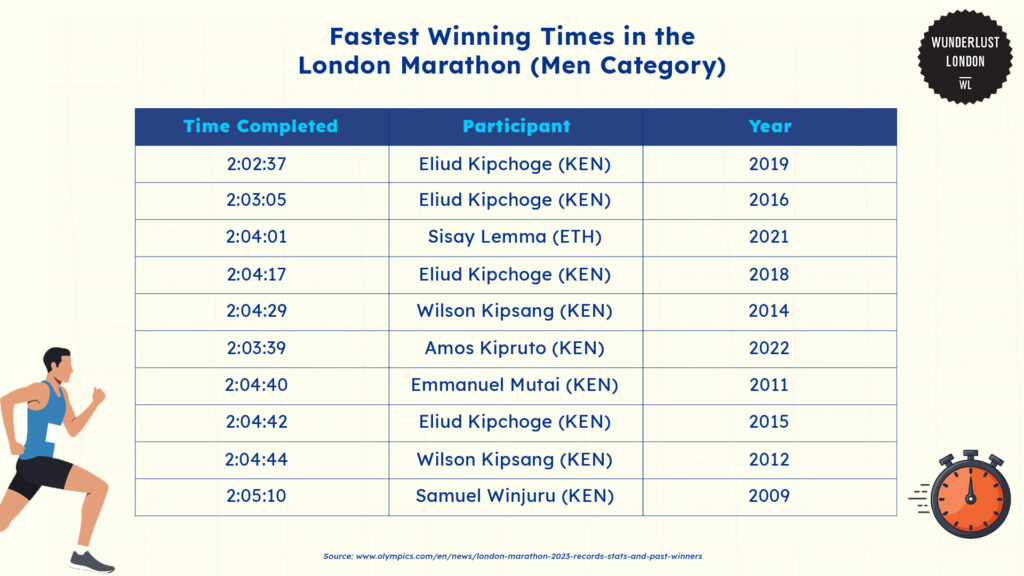
The Olympics shared the fastest marathon finishers in the men’s category. A clear trend emerges, with Kenyan runners dominating the event and only one Ethiopian winner listed.
Eliud Kipchoge stands out as the most successful athlete here, winning multiple times across different years. His fastest recorded time is from 2019, when he finished in 2:02:37. It’s also the quickest among the listed results.
Looking at the times over the years, there is a noticeable improvement.
Earlier winners, like Samuel Wanjiru in 2009, finished in just over 2:05, while more recent victories have been in the low 2:03 range.
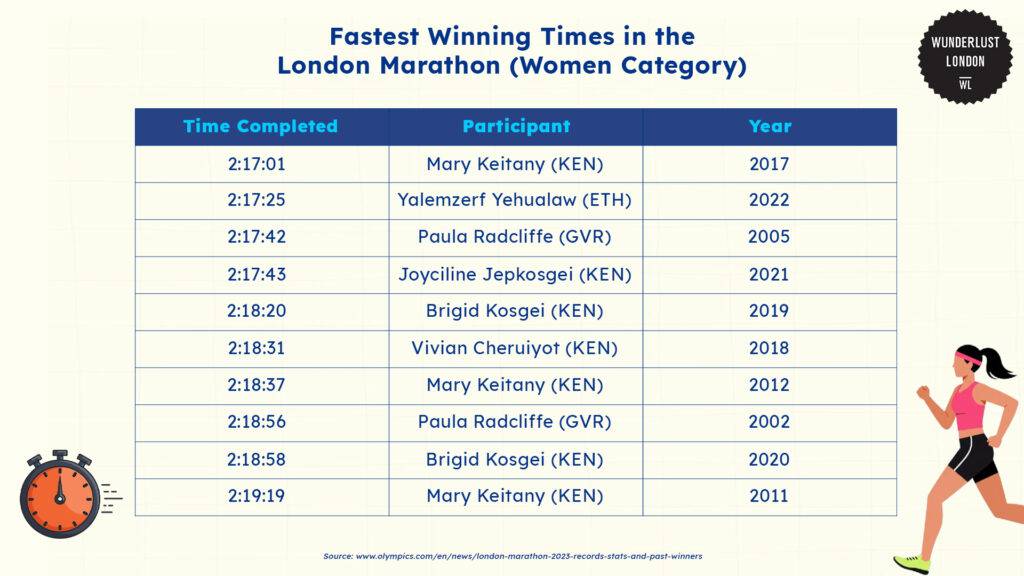
For the women’s category, the Olympics also presented the fastest winning times in the London Marathon. There’s also a strong presence of Kenyan runners alongside a few athletes from Ethiopia and Great Britain.
The times are remarkably close, with the fastest recorded at 2:17:01 by Mary Keitani in 2017. The competitiveness of the event was highlighted as several winners finished within seconds of each other.
Kenyan female athletes dominate the list, reflecting the country’s well-established reputation in long-distance running.
However, Paula Radcliffe’s presence as the only British runner among the top times shows that elite performances are not exclusive to East African nations.
The fastest time on the list was set by Yalemzerf Yehualaw from Ethiopia in 2022, suggesting that the competition remains dynamic.
Participant demographics in the London Marathons
London Marathon participant distribution by gender
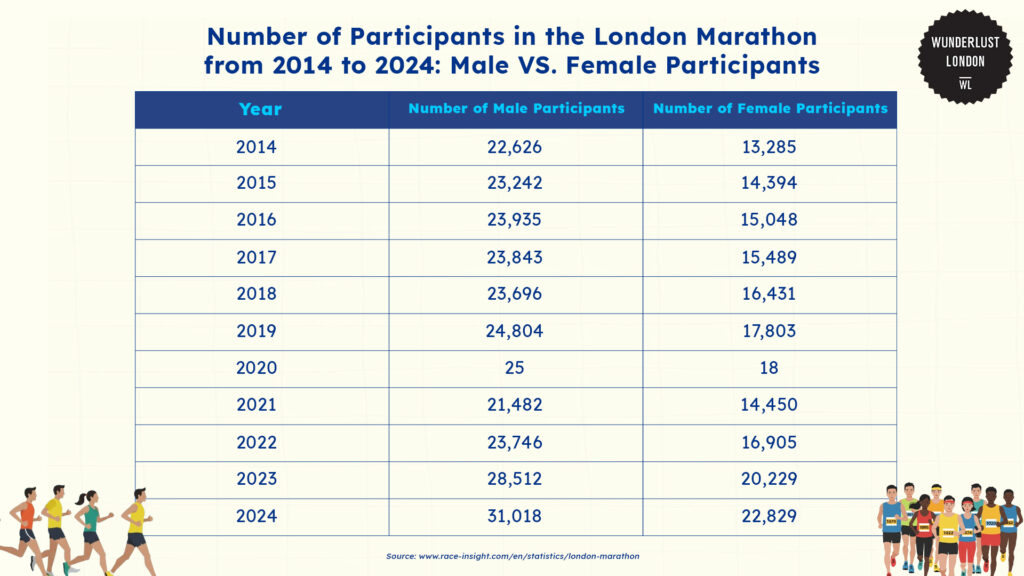
According to data from Race of Insights, male participants consistently outnumbered female participants each year from 2014 to 2024. However, both groups have seen an overall increase in participation.
In 2024, both genders showed the highest number of participants, with 31,018 men and 22,829 women.
A big drop appeared in 2020, when participation fell drastically to just 25 male and 18 female runners. This was at the same time as the COVID-19 pandemic hit the whole world.
While the gap between male and female runners remains, the number of female participants has risen significantly over the years. This suggests greater inclusivity and interest in marathons among women.
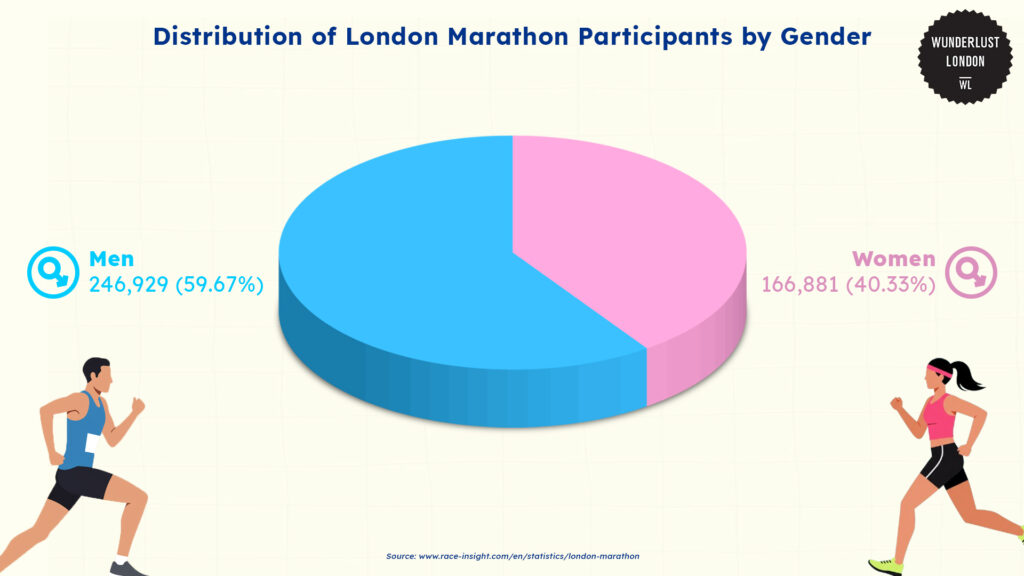
In percentage, Race of Insights provided data that shows the overall distribution of London Marathon participants by gender.
Out of the total participants, 59.67% were men, while 40.33% were women. The nearly 60-40 split suggests that marathon running, which has historically been male-dominated, is gradually becoming more gender-inclusive.
London Marathon participant distribution by age
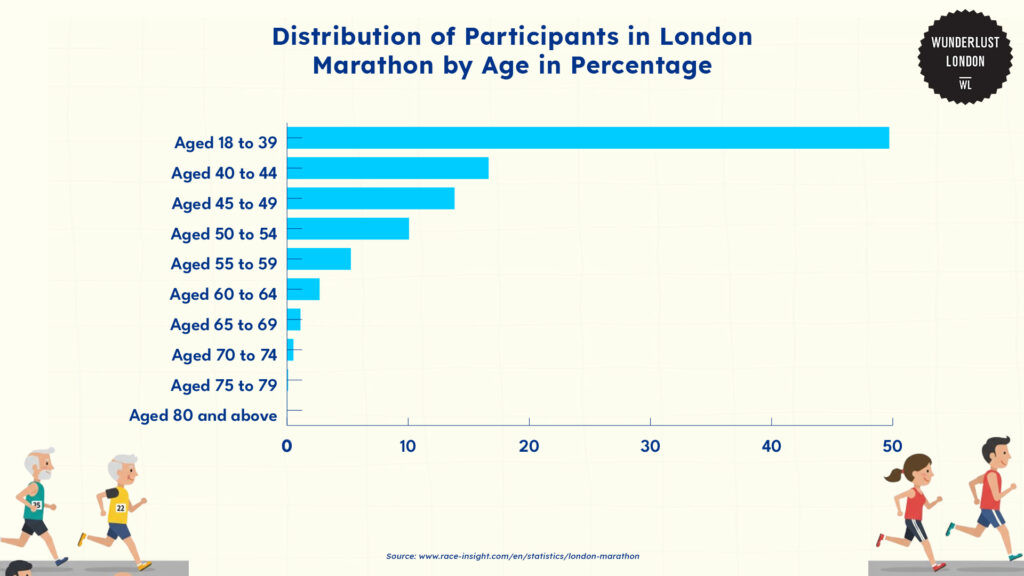
According to the data provided by Race Insight, nearly half (49.71%) of all participants fall within the 18 to 39 age range.
Marathon running remains most popular among younger adults. This is likely due to factors such as physical endurance, training commitment, and fewer age-related constraints.
After 40, participation starts to drop. The 40 to 44 age group still has a decent number (16.64%), and the 40 to 49 group follows at 13.83%.
As the age groups went higher, the number of participants declined. This trend is expected since running a marathon is physically demanding.
London Marathon participant distribution by country
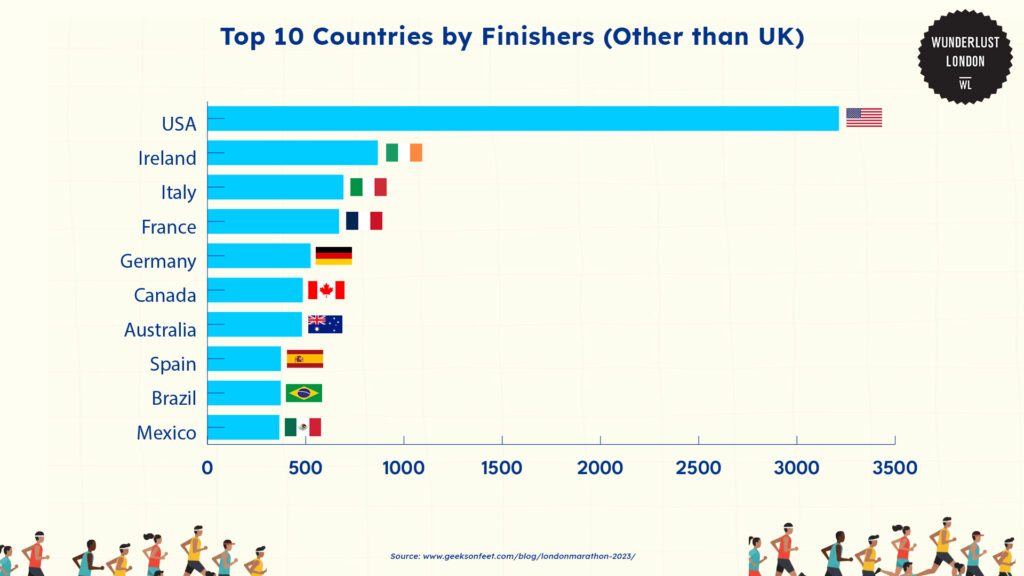
Geeks on Feet shared their findings about the top countries (excluding the UK) with the most finishers in the 2023 London Marathon.
The USA has the largest number by far, with 3,214 finishers. This isn’t surprising, as the London Marathon is a major international event, and many American runners travel for big races.
Ireland comes next with 867 finishers, which makes sense given its close proximity to the UK.
Other European countries like Italy (692), France (670), and Germany (525) also have strong participation. This is likely due to the ease of travel and a shared enthusiasm for marathons.
Despite being far from London, Canada (485) and Australia (481) still have a solid number of runners. Spain, Brazil, and Mexico round out the list, each with just under 400 finishers.
This means that while marathon culture is strong worldwide, travel distance may affect participation.
Charitable impact and fundraising milestones of the London Marathon
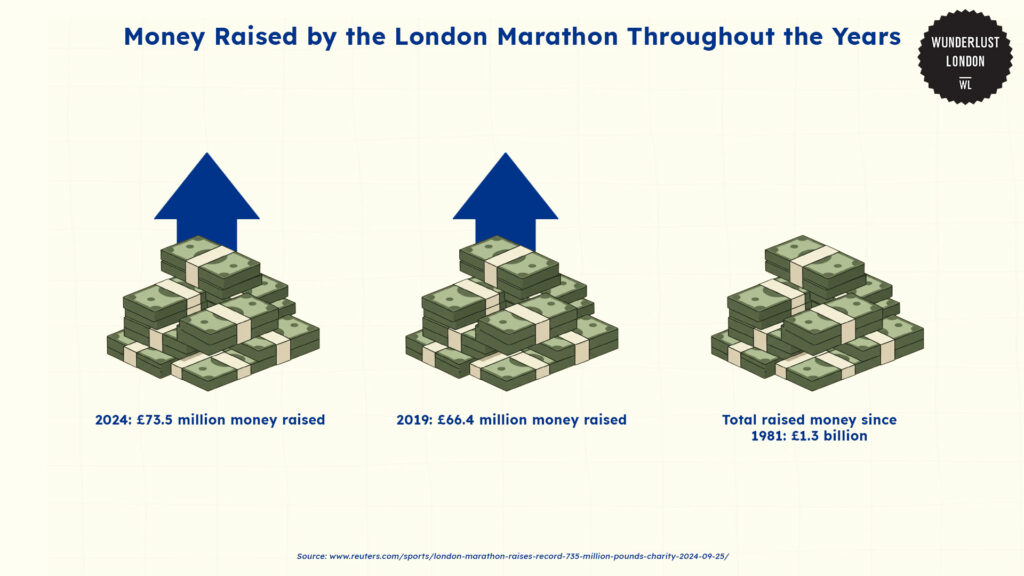
The London Marathon isn’t just about running. It’s also one of the biggest fundraising events in the world.
Reuters shared that 2024 participants and supporters raised £73.5 million for charity, breaking the previous record of £66.4 million set in 2019.
Since the first race in 1981, the marathon has raised a total of over £1.3 billion for various causes.
Many runners take part specifically to raise money for charities, with major organisations like Cancer Research UK, Macmillan Cancer Support, and Great Ormond Street Hospital benefiting from the donations.
Economic activity in the London Marathon
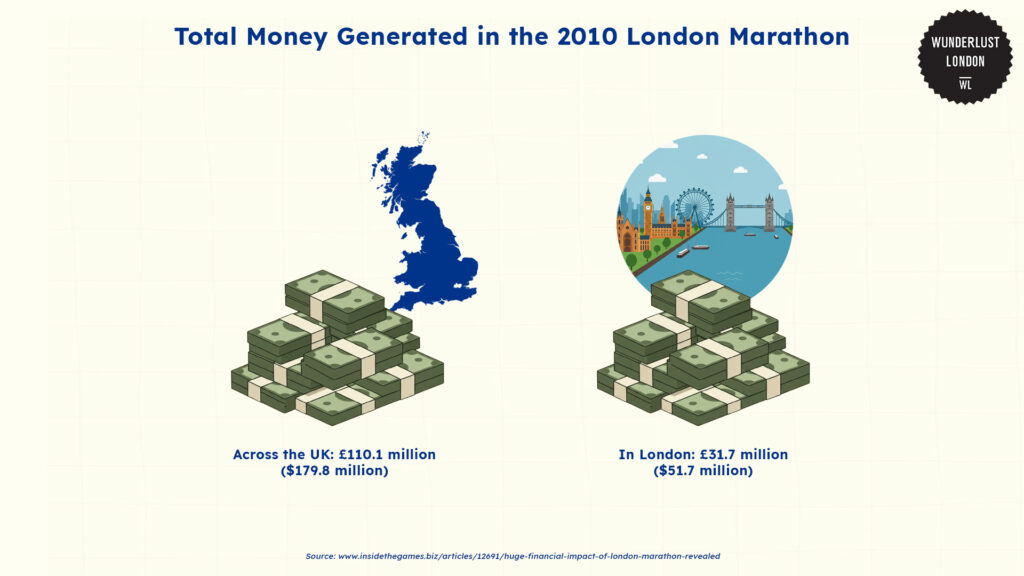
The London Marathon significantly boosts the UK’s economy each year. In 2010, the event generated £110.1 million in economic activity across the country, as reported by Inside the Games.
Of this, £31.7 million was spent directly in London by runners, spectators, organisers, and visitors.
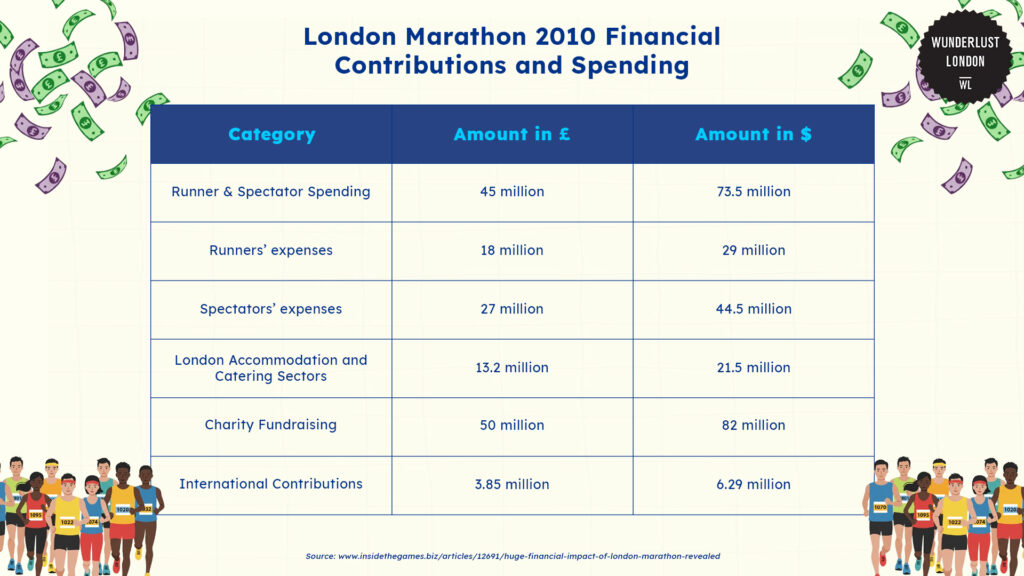
According to Inside the Games, a big portion of the economic impact comes from the runners themselves, as preparing for the marathon involves investing in the right gear.
On average, each runner spent around £452 on running shoes, apparel, and preparation, adding up to a total of £18 million.
Spectators, including friends and family who came to support the runners, also contributed £27 million. A big chunk of this went to accommodation, food, and drinks, making tourism-related businesses some of the biggest winners.
Hotels and restaurants alone also made £13.2 million from the influx of visitors, showing how the event played a key role in boosting local businesses.
Beyond direct spending, the marathon also raised £50 million for charities, which is double since 2000.
Additionally, international contributions brought in another £3.85 million. This includes money from overseas visitors and TV rights.
Unusual Guinness World Records in the London Marathon
The London Marathon serves as a stage for runners aiming to set extraordinary Guinness World Records each year. Most often, it involves creative costumes and impressive feats.
According to the London Marathon Events, an impressive 45 new records were set in the 2023 edition. This is, by far, the highest number of Guinness World Records ever achieved in the history of the London Marathon.
Below are the top 10 Guinness World Records Titles with the fastest time finished.
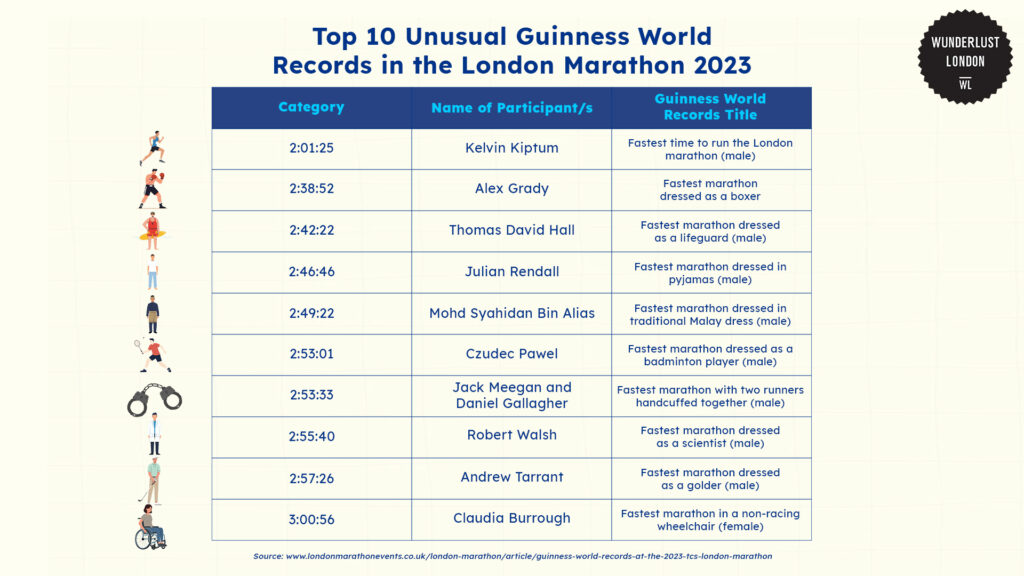
Based on the data recorded by the London Marathon Events, one of the most impressive records was Kelvin Kiptum’s time of 2:01:25. This made him the fastest man to complete the London Marathon.
Beyond elite racing, the event was filled with quirky records. Others added cultural and scientific themes to their runs as well.
These records highlight that the London Marathon is not just about competition but also fun, personal expression, and pushing limits in unique ways.
Recent developments in the London Marathon
Record-breaking applications for the 2025 London Marathon
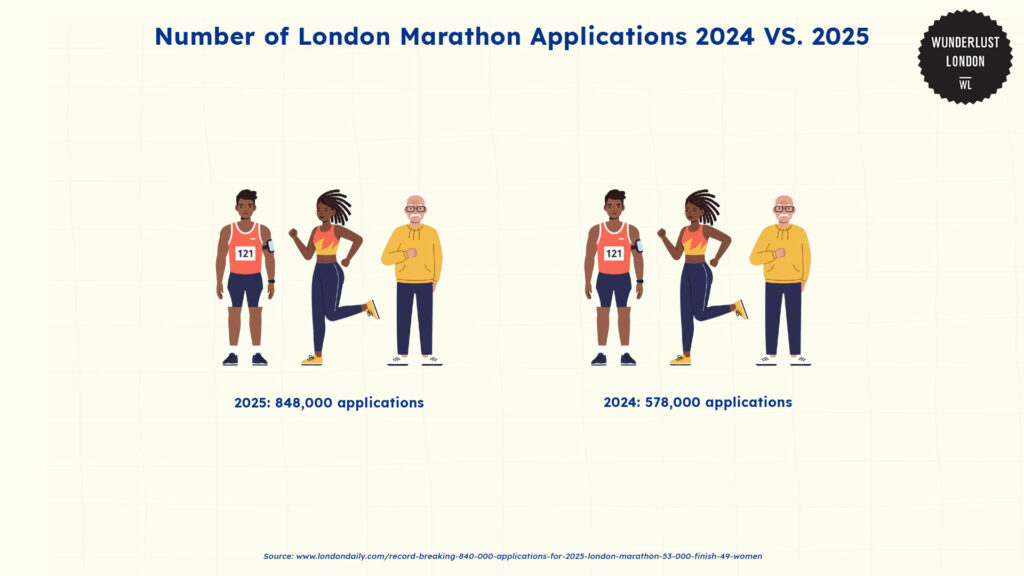
According to the London Daily, the 2025 London Marathon has set a new record with over 848,000 applications. This figure surpassed the previous record of 578,000 applications in 2024.
Out of these applications, 672,631 came from the UK, with almost an equal split between men (50.33%) and women (49.03%).
This is a big jump in female applicants compared to 2024, when only 43% were women.
Another 167,687 people from around the world also applied through the international ballot.
Growing interest in marathons among young participants
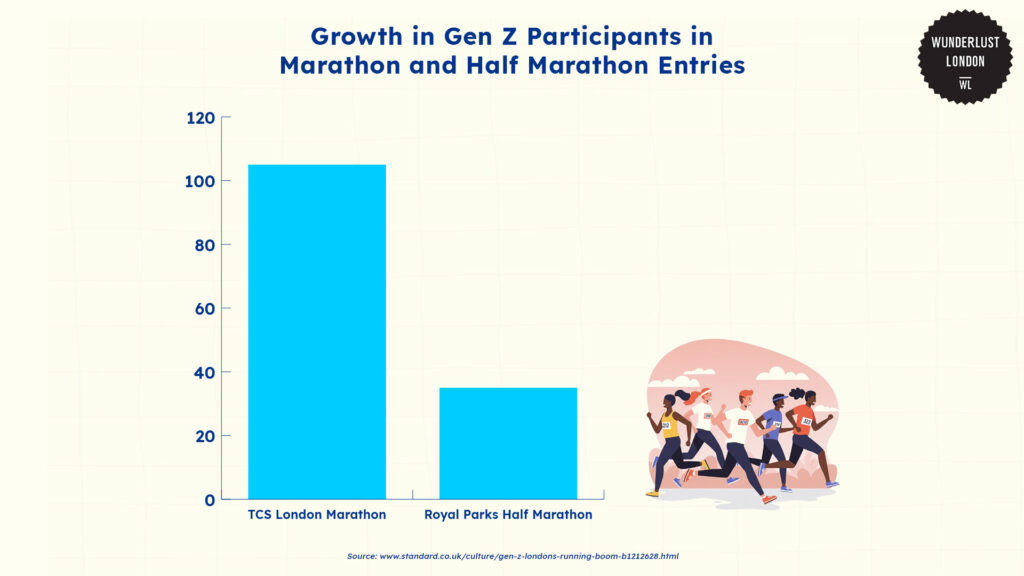
According to The Standard, the TCS London Marathon saw a 105% increase in entries from 20-29-year-olds this year.
A record of 840,318 people entered the ballot, making this age group the second-largest demographic in the event.
The Royal Parks Half Marathon also set a record, with a 35% rise in entrants compared to 2024.
Gen Z’s shift toward fitness over nightlife is driving this trend. Many drink less post-pandemic, with apps like Strava making running social and competitive.
Non-binary entry options for the London Marathon
In 2023, the London Marathon took a big step toward inclusivity. According to the London Marathon Events, a non-binary entry option was introduced.
For the first time, runners could choose to register as male, female, or non-binary. This makes the event more welcoming to people of all gender identities.
This option was available for all general participants, including those running for charity. However, elite races and certain competitive categories, which follow World Athletics rules, still required runners to register as male or female.
References
- 2023 TCS London Marathon ballot entry to include non-binary option. London Marathon Events. (2022). https://www.londonmarathonevents.co.uk/london-marathon/article/2023-tcs-london-marathon-ballot-entry-to-include-non-binary-option
- The financial footprint of the London Marathon. ICAEW. (2023). https://www.icaew.com/learning-and-development/careers-plus-hub/discover-chartered-accountancy/the-financial-footprint-of-the-london-marathon
- Guinness World Records at the 2023 TCS London Marathon. London Marathon Events. (2023). https://www.londonmarathonevents.co.uk/london-marathon/article/guinness-world-records-at-the-2023-tcs-london-marathon
- Howe, M. (2025). Gen Z could be driving London’s recent running boom. The Standard. https://www.standard.co.uk/culture/gen-z-londons-running-boom-b1212628.html
- London Marathon 2023: A data round up. Geeks on Feet. (2023). https://geeksonfeet.com/blog/londonmarathon-2023/
- London Marathon raises record 73.5 million pounds for charity. Reuters. (2024). https://www.reuters.com/sports/london-marathon-raises-record-735-million-pounds-charity-2024-09-25/
- Mackay, D. (2011). Huge financial impact of London marathon revealed. Inside the Games. https://www.insidethegames.biz/articles/12691/huge-financial-impact-of-london-marathon-revealed
- Record-breaking 840,000 applications for 2025 London Marathon: 53,000 finish, 49% women. London Daily. (2025). https://londondaily.com/record-breaking-840-000-applications-for-2025-london-marathon-53-000-finish-49-women
- Statistics – London Marathon. Race Insight. (2024). https://www.race-insight.com/en/statistics/london-marathon
- Watta, E. (2023). London Marathon: Records, stats and past winners. Olympics. https://www.olympics.com/en/news/london-marathon-2023-records-stats-and-past-winners


